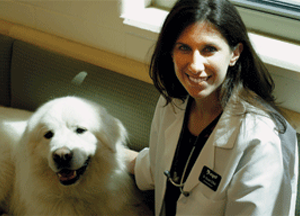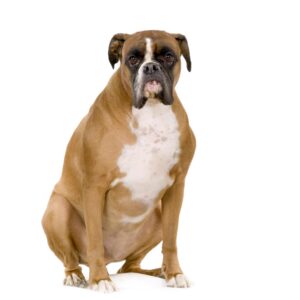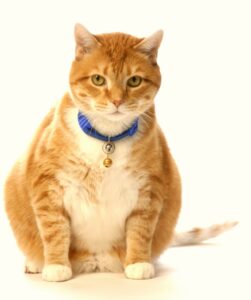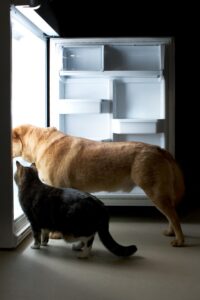-
Adopt
-
Veterinary Care
Services
Client Information
- What to Expect – Angell Boston
- Client Rights and Responsibilities
- Payments / Financial Assistance
- Pharmacy
- Client Policies
- Our Doctors
- Grief Support / Counseling
- Directions and Parking
- Helpful “How-to” Pet Care
Online Payments
Referrals
- Referral Forms/Contact
- Direct Connect
- Referring Veterinarian Portal
- Clinical Articles
- Partners in Care Newsletter
CE, Internships & Alumni Info
CE Seminar Schedule
Emergency: Boston
Emergency: Waltham
Poison Control Hotline
-
Programs & Resources
- Careers
-
Donate Now
 By Susan O’Bell, DVM, MPH, DACVIM
By Susan O’Bell, DVM, MPH, DACVIM
www.angell.org/generalmedicine
generalmedicine@angell.org
617-522-7282
Of ever-growing concern among veterinarians and pet owners is the epidemic of overweight and obese body conditions. Multiple variables play a role, but diet and lifestyle are often at the heart of the matter, just as we see with humans facing the same daunting, dangerous health conditions.
 The simple truth: Is my dog or cat too fat?
The simple truth: Is my dog or cat too fat?
Recognizing a healthy body condition is the first step in tackling this epidemic. When in doubt, this is the perfect time to visit your veterinarian. I always recommend this before launching any sort of weight loss program. Starting at your puppy or kitten visits, or even with your fully grown companion, your veterinarian can teach you some questions to ask yourself as you examine your pet and try to keep those waist lines in check. Do you have trouble seeing or feeling your pet’s ribs or a waist-line from a “top view” or “side view” of your pet? Do they have sagging bellies? Do they seem tired or lazy? Some specific causes for concern in cats include: looking under-groomed especially on their backs and hind ends, not engaging in play sessions, or hesitating before jumps. In dogs, some signs compatible with overweight conditions include: panting a lot, lagging behind on walks, and cutting play sessions short. If the answer is yes to any or all of these questions, you, your pet, and your veterinarian probably have some work to do! In the office setting we determine a body condition score on a 9 point scale or a 5 point scale (with 1 being too thin and 9 or 5 being obese depending on the scale used). Nutritionists at Hill’s Science Diet have also been instructing us in what may be a more objective way of determining just how overweight a dog or cat might be. It can be hard to know what the ideal weight is once we are so far beyond it!
Prevention: Portions and play-time matter
For those of you lucky enough to have a pet with a currently ideal body condition, or the “clean slate” of a puppy or kitten who still has his or her ideal body condition, let’s talk about keeping it that way. You probably already know that diet and exercise are cornerstones of weight management, but this is where consultation with your veterinarian can be essential. Most of my clients really don’t know how many calories their pets need each day, or how vastly the calorie content of different brands of food can vary, or how any little treat or table scrap can add up throughout the day. First find out what your pet’s daily calorie allowance is from your veterinarian based on your pet’s age, current body condition, lifestyle/exercise and taking into account any underlying medical considerations. Second, use a standard 8 ounce measuring cup and/or dietary scale to measure the amount and confirm with your veterinarian how these calories translate into measured amounts. Usually the caloric content of a food is printed (in small print) on the food label (“kcal/cup” refers to a standard 8 oz. measuring cup). Third, get everyone in the household on board with your weight management plan (this may be tougher than you think!). There are some vegetables and fruits that are safe for pets to eat that may be offered as low calorie treats. Or  try freezing yogurt in your puppy’s “Kong” toy instead of peanut butter. Lastly, make time daily for exercise. The best way to exercise with your dog is to set a “date” with them. While generally playing in any way with your pet is good, dogs and cats both benefit from a predictable routine (and are often better behaved because of it). Ideally keep your pet constantly moving, so a walk around the neighborhood may be superior to tossing a ball depending on the pet. Start slowly and stick with your routine. Don’t expect your pet to take to even a half hour of sustained exercise if they have been accustomed to a sedentary lifestyle previously. The same goes for your cat. Even 5 minutes with some “high prey drive” toys such as “cat dancers,” feather toys or laser pointers can make a difference, and you should be able to gradually increase the amount of time your cat feels like playing each week. Multiple studies show the mutual benefits both mentally and physically of exercising with your pet — this is one place the internet can be a great resource if you need help brainstorming activities you both may enjoy together.
try freezing yogurt in your puppy’s “Kong” toy instead of peanut butter. Lastly, make time daily for exercise. The best way to exercise with your dog is to set a “date” with them. While generally playing in any way with your pet is good, dogs and cats both benefit from a predictable routine (and are often better behaved because of it). Ideally keep your pet constantly moving, so a walk around the neighborhood may be superior to tossing a ball depending on the pet. Start slowly and stick with your routine. Don’t expect your pet to take to even a half hour of sustained exercise if they have been accustomed to a sedentary lifestyle previously. The same goes for your cat. Even 5 minutes with some “high prey drive” toys such as “cat dancers,” feather toys or laser pointers can make a difference, and you should be able to gradually increase the amount of time your cat feels like playing each week. Multiple studies show the mutual benefits both mentally and physically of exercising with your pet — this is one place the internet can be a great resource if you need help brainstorming activities you both may enjoy together.
Management – no binge diets please!
 Launch any weight loss program with your veterinarian’s blessing and expertise. Your dog or cat may need to be screened for certain weight loss conditions associated with obesity. Some diets may be contraindicated based on your pet’s pre-existing health problems, and over-restricting certain types of food may result in a nutritionally deficient diet leading only to further health problems. There are several approaches to weight loss diets for both dogs and cats, and some may be more successful than others from one pet to another. You may still be able to work with the food you are currently feeding your pet if portion and lack of exercise are the main problems. Diets that are only available through your veterinarian (“Prescription diets”) may be recommended depending on the severity of your pet’s condition, your past success (or lack thereof) with commercially available diets, and your pet’s eating style. The newest prescription weight loss diets use a foundation in gene therapy to help jumpstart your pet’s metabolism. Some clients may be concerned about the cost of a prescription diet, but getting your pet’s condition under control is far less expensive than managing the potential health outcomes associated with obesity such as orthopedic issues in both dogs and cats and/or diabetes mellitus. Perhaps the greatest motivation to help your pet should be the fact that pets of a healthy weight live longer!
Launch any weight loss program with your veterinarian’s blessing and expertise. Your dog or cat may need to be screened for certain weight loss conditions associated with obesity. Some diets may be contraindicated based on your pet’s pre-existing health problems, and over-restricting certain types of food may result in a nutritionally deficient diet leading only to further health problems. There are several approaches to weight loss diets for both dogs and cats, and some may be more successful than others from one pet to another. You may still be able to work with the food you are currently feeding your pet if portion and lack of exercise are the main problems. Diets that are only available through your veterinarian (“Prescription diets”) may be recommended depending on the severity of your pet’s condition, your past success (or lack thereof) with commercially available diets, and your pet’s eating style. The newest prescription weight loss diets use a foundation in gene therapy to help jumpstart your pet’s metabolism. Some clients may be concerned about the cost of a prescription diet, but getting your pet’s condition under control is far less expensive than managing the potential health outcomes associated with obesity such as orthopedic issues in both dogs and cats and/or diabetes mellitus. Perhaps the greatest motivation to help your pet should be the fact that pets of a healthy weight live longer!
Lastly, check out the weight management tools provided below. Even if your pet eats a different brand of food, the information provided at these sites is both accurate and entertaining.
http://www.hillspet.com/weight-management/index.html
http://www.projectpetslimdown.com/
For information about Angell’s General Medicine service, please visit www.angell.org/generalmedicine or call 617-522-7282.